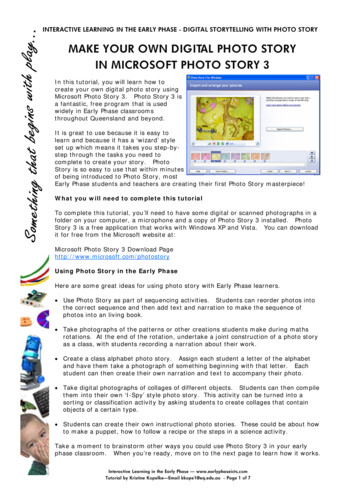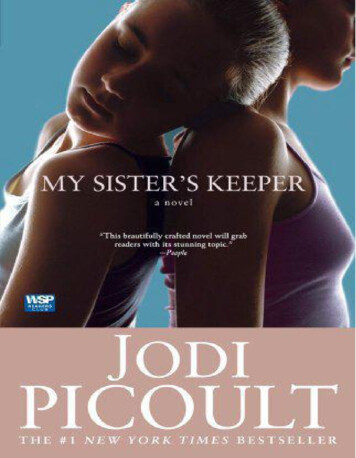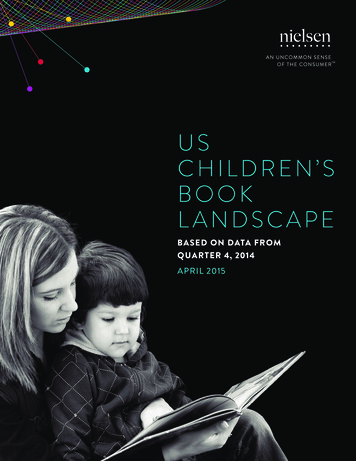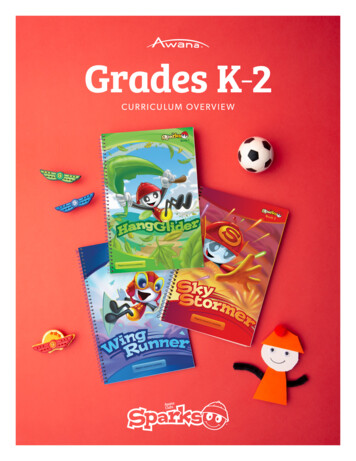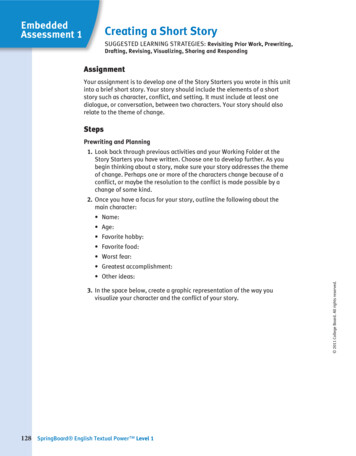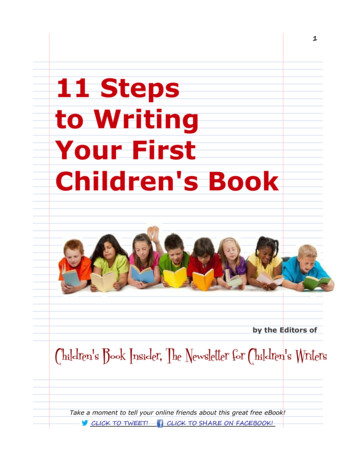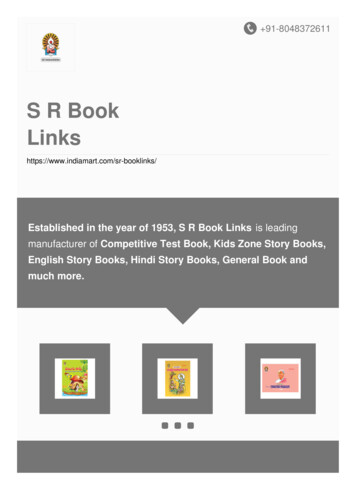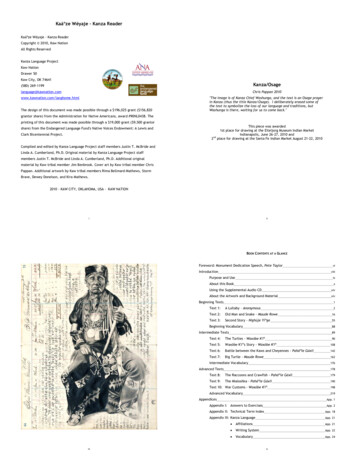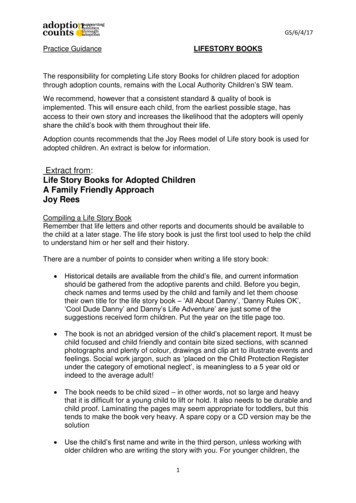
Transcription
GS/6/4/17Practice GuidanceLIFESTORY BOOKSThe responsibility for completing Life story Books for children placed for adoptionthrough adoption counts, remains with the Local Authority Children’s SW team.We recommend, however that a consistent standard & quality of book isimplemented. This will ensure each child, from the earliest possible stage, hasaccess to their own story and increases the likelihood that the adopters will openlyshare the child’s book with them throughout their life.Adoption counts recommends that the Joy Rees model of Life story book is used foradopted children. An extract is below for information.Extract from:Life Story Books for Adopted ChildrenA Family Friendly ApproachJoy ReesCompiling a Life Story BookRemember that life letters and other reports and documents should be available tothe child at a later stage. The life story book is just the first tool used to help the childto understand him or her self and their history.There are a number of points to consider when writing a life story book: Historical details are available from the child’s file, and current informationshould be gathered from the adoptive parents and child. Before you begin,check names and terms used by the child and family and let them choosetheir own title for the life story book – ‘All About Danny’, ‘Danny Rules OK’,‘Cool Dude Danny’ and Danny’s Life Adventure’ are just some of thesuggestions received form children. Put the year on the title page too. The book is not an abridged version of the child’s placement report. It must bechild focused and child friendly and contain bite sized sections, with scannedphotographs and plenty of colour, drawings and clip art to illustrate events andfeelings. Social work jargon, such as ‘placed on the Child Protection Registerunder the category of emotional neglect’, is meaningless to a 5 year old orindeed to the average adult! The book needs to be child sized – in other words, not so large and heavythat it is difficult for a young child to lift or hold. It also needs to be durable andchild proof. Laminating the pages may seem appropriate for toddlers, but thistends to make the book very heavy. A spare copy or a CD version may be thesolution Use the child’s first name and write in the third person, unless working witholder children who are writing the story with you. For younger children, the1
GS/6/4/17less direct approach is a more effective and less threatening way of exploringtheir history. Toddlers use their names rather than ‘I’ or ‘me’ and onlygradually develop a sense of self. Many adopted children function at a veryyoung emotional age, and adopters are encouraged to ‘think toddler’. Usingthe third person in the book mirrors this developmental process Currently, the average age of children being adopted in the U.K. is 4 yearsold. Irrespective of age, when preparing the book, you should make itappropriate for a school-age child (roughly 5 to 10 years old). They mayalready have gone through the book many times, but it is only when they startschool that children begin to understand the emotional significance of theiradoption. Prior to this some will assume that, just like them, everyone hasbeen fostered and adopted A school project about families and requests for baby photographs raisesmany issues for an adopted child. Changes in the way thoughts areprocessed and in brain integration are also occurring at this age, which canlead to further questions Parents who have adopted children as babies or toddlers often notice achange in their children at this stage. Some sense an undercurrent of sadnessor ‘grumpiness’, while others comment on increased concerns, difficulties,lethargy, anger or aggression. ‘Attachment issues’ become more apparent,and adopters may feel confused and ineffective as parents, as they begin toabsorb the child’s emotions It is at this stage that an adoptive parent will be able to use a sensitivelywritten life storybook to most effect. While reminding the adopters about thechild’s history, it can also be used to reassure their child and to help the childto unravel the confused thoughts and emotions they are struggling tounderstandThe format:Present Past Present Future Beginning the story with the child’s birth and with the birth parents’ details andhistory will be overwhelming and is not a good way to promote a secureattachment between the adopters and child. In doing so, the adopters arebeginning by reminding the child that they are not ‘mummy’ or ‘daddy’. Thinkof the subliminal messages here, for both child and adopter! Helping the child to feel safe, contained and ‘grounded’ in the present is amore appropriate starting point. From this position the adoptive parent canhelp their child to look back and begin to make some sense of their history To understand ourselves fully and move on to the future we need tounderstand our past, but young children live very much in the present andhave a limited understanding of ‘yesterday’ or ‘tomorrow’. Many older adopted2
GS/6/4/17children have a similarly fragile grasp of time, so first we need to give them amuch stronger sense of their present1. Present Start the book with the present: the child as s/he is now, with scannedphotographs of the adoptive family and the home. Include a generaldescription, a photograph of the child, and one with mum and dad (i.e.adoptive mum and dad). They should feature at the beginning and not betacked on, almost as an afterthought, at the end. Do not refer to them as ‘new’mummy and daddy – just as mummy and daddy, and do so throughout thebook Make sure there are many positive comments about the child right from thestart. For example, sparkly/twinkling eyes, lovely/sunny smile or soft/shinyhair. The adopters need to be very involved, so include positive commentsfrom them about their son or daughter and their talents, interests, nick namesetc - and interweave these positives throughout the body of the book Be mindful of the subliminal messages. Children need to feel positive aboutthemselves – that they are important, loveable and lovedIf the child is at nursery or school, add a few comments and pictures andmention names of teachers, pick out any positive comments they have made,and mention favourite subjects and names of friends If children are struggling with school there will still be positive comments toinclude. They may be great at helping the teacher to put things away, or goodat cutting and sticking, kind to other children or amazing at cartwheels!. Feedthe positives and don’t dwell on the negatives. The life book is not the placefor this!For children who find separations difficult, parents may find that they arefrequently asked to collect the children early from school, either because theyare upset, feeling ill, or they have become disruptive in some way. Childrenexpress separation anxiety in many different ways and this issue could bealluded to indirectly by mentioning that while the child is at school hismum/dad still think about him as they are cleaning the house, shopping,working at the office, etc. Out of sight is not out of mind - and this needs to beconstantly reinforced in all kinds of ways Now write about the child’s name and scan in a copy of the birth certificate(i.e. the new certificate showing the adoptive name). Mention the meaningand significance. This could lead to a simple explanation about the change tothe child’s birth name, and the concept of adoption can be introduced. Forexample, children join families in different ways, some are born into them,some are fostered and some are adopted, etc If giving examples of other people who have been fostered or adopted, makethese meaningful to the child. For older children Moses, Aristotle, NelsonMandela, Kate Adie or Fatima Whitbread may be appropriate but will mean3
GS/6/4/17little for younger children. For a 4 or 5 year old, Superman, Stuart Little themouse or Babe the pig will have far more of an impact. Bring in positiveexamples of relatives or friends within the adoptive parents’ network who werealso adopted .Think about the child’s world and reinforce their own points ofreference For inter country adoptions, many children are ‘abandoned’ and their birthsare not registered by birth parents. However the same format is still helpfuland an honest but sensitive explanation is still needed. For example: Kas’s mum and dad gave him the name Kasem, but it is usually shortened toKas. His mum and dad chose the name because it is Thai for being ‘well andhappy’ and because they thought that it was just the right name for Kas. Hismiddle name is Virote, and this is Thai for ‘great power’. Virote is the namethat was chosen for him in Thailand before he came to live with his mum anddad in Newtown2. Past Having explored and endorsed the present for the child, it is now time tointroduce the past. Start with the beginning: - the child’s birth If there is little information about the birth, use some ‘poetic licence’ –generally we can assume that babies were born gorgeous, lovely, adorable,loveable little bundles. Details of birth weight and length and time and day ofbirth are usually available for all domestic adoptions and should be included. Ifthe child was premature, or unwell and in a special care unit, include details ofthis All babies have a birth mother and a birth father, so simply say this. Give thebirth mother’s name and, if available the birth father’s name, and from then onrefer to them using their first names only. Scan in one or two photographs ifthey are available. (The originals and other birth family photographs can besafely put in a separate photograph album for them.) There may be a fewexceptions, when photographs of the birth parents should not be included inthe book. For example, for children who have experienced extreme violenceor sexual abuse, photographs may re-traumatize and not be appropriate If the birth father has not been identified, and there is no information available,this must be acknowledged. Not mentioning a birth father could lead the childto believe the father is just so ‘bad’ he has to remain a secret, or the child maygrow up assuming that their adoptive father is actually their birth father. Forexample:All children have a birth mother and a birth father. Peter’s birth mother iscalled Jane etc. Peter’s birth father is called, Steve. Very little is known aboutSteve. Jane said that he was about the same age as her and about the sameheight. He had a medium build and brown hair. Steven and Jane hadn’t4
GS/6/4/17 known each other for very long and their friendship had ended a few monthsbefore Peter was born. Jane thought that he was a lorry driver and that hewas from Wales. He may have gone back to that area to live, but she wasn’tsure.Most adopted children were welcomed into the world by their birth parents.The birth parent would have felt love for the child and may have breast fed,registered the birth, and chosen a name with great care and for a particularreason. All this should be mentioned Give basic details of significant members of the birth family: ages, physicaldescriptions, ethnic and cultural information, religion, personalities,occupations, interests, hobbies, and talents. Do not overload with intimatedetails of the birth parents’ history. Keep this section positive and short There has been much debate about the difference between being ‘loved’ andbeing ‘loveable’ and some may feel that being told that a neglectful or abusiveparent loved him/her will be very confusing for a child. However manyadopted children were wanted and loved by their birth parents and it would bewrong to deny this, even if those same parents were later unable to parent thechild appropriately. We need to be more creative about the way we explainand explore the nature of love and parenting within life storybooks There needs to be a sensitive and honest account of the events/concernsleading to the child’s relinquishment or removal from the birth parents. Neglector abuse needs to be explained in a very simple and non-judgemental way.Comments about the birth mother’s ‘inability to meet your physical andemotional needs’ will mean nothing to a childFor example, children understand their basic needs, such as the need for food andclothing, or to go to school, or for lots of cuddles as a baby. They need to know thattheir birth parent simply didn’t know how to look after them properly, and certainly notin the way that such a precious and loveable child deserved For inter county adoptions there is often little or no information about birthfamily and an honest and sensitive explanation is still needed. For example:Kas was born Thailand, and like all babies he had a birth mother and birth father,although very little is known about them. There were both from Thailand and just likeKas they would have had lovely dark shiny hair and brown eyes and skin.Kas’s birth mother may have been very young or very poor, as a few days after Kaswas born she decided that she wouldn’t be able to look after him properly, so shetook him to a baby’s nursery in Cha -Am.She must have carried Kas there and she carefully placed him in a little basket, nearthe entrance of the nursery, so the nurses who looked after the babies would be sureto see him. She would have known that they would take good care of him. And this isexactly what happened. When the nursery nurse saw him she picked him up verycarefully. She looked all around but they were not able to find Kas’s birth motheranywhere. The police came too and they searched, but they could not find anyoneeither.5
GS/6/4/17Kas was a beautiful and very loveable baby. He was very healthy and social workerswho came to see him and the nannies who looked after him at the 66
GS/6/4/17nursery all agreed that he was indeed a really gorgeous little bundle. They chose thename Virote for him as it means ‘powerful’ and they all agreed that he was indeed avery strong little baby, so the name seemed just right for him. Giving an honest account of the circumstances leading to their adoption, whileacknowledging sadness and loss, should make it clear that any neglect orabuse was not the child’s fault. Words need to be carefully chosen to ensurethat they do not feed in to the child’s sense of blame and shame Lengthy accounts of the birth parent’s unhappy childhood, and explanations ofthe ‘root cause’ of their difficulties, should not be in the child’s book. Childrenmay feel somehow responsible for the birth parent’s sadness or inadequacies,and believe that as the abuse or neglect was not really their birth parent’sfault, it must be theirs – again reinforcing their sense of ‘badness’ Detailed information about case conferences, care proceedings and specificdates is not needed. Keep these details for the ‘Later life letter’ and otherreports that will be available to the child when older. They will over-complicateand actually detract from the child’s understanding of their story Give information and photographs about the foster carers – but again not toomuch, as children should now be given a memory book or box of their timewith the carers. If there were several fostering placements, this is usually dueto the carers’ other commitments, so choose words carefully to ensure thatthe child does not think that they moved to other foster carers or to theadoptive parents for ‘being naughty’ Bring the story back to the adopters. Again, protracted explanations about‘Adoption Panels’ and ‘Matching Meetings’ are not needed. There is usually aphotograph of the child’s first meeting with the adopters and they themselvesmay have positive comments about this to quote in the book. Some adopterssay ‘It was love at first sight’ or they have another positive memory oranecdote to tell. Usually at this stage, the children in photographs look tenseand anxious, so avoid captions about how happy and delighted the child wasto have a ‘new mummy and daddy’ While it might be appropriate to commenton the adopters’ sense of joy, acknowledge the understandable ambivalenceof the child Give some details of the move to the adopters’ home, including how strange itmust have been for the child at first. Comment on all the different things thechild had to get use to – different people, a different house, a differentbedroom, different food, different words for things, different smells andsounds, different feelings, different colours and furniture, differentnursery/school and so on. So many differences! Comment on the adoptive parents’ knowledge and understanding of the child,and how they knew about all the things needed to keep a child happy, healthyand safe. It may be appropriate to mention that they also realised that some ofthe child’s previous experiences may have left him/her feeling, worried,7
GS/6/4/17wobbly, upset, cross, angry or sad. This could provide an opportunity for theadoptive parent to explore facial expressions and feelings with the child Writing in the book in the 3rd person also affords more opportunity for gentleor playful conjecture with regard to the child’s emotions. ‘I expect that Johnmay have felt.’ or ‘I wonder if John felt.’ allows for further discussionbetween the child and parent. The child can either identify with, or reject thesuggested feelings If the child has particular problems, such as bed-wetting, nightmares or eatingdifficulties, this could be tentively explored via the book – but never in directreference to the child. For example:If children keep them all their worries inside, their insides may soon become so full itcan’t hold them all in. These scary feelings can sometimes make children feel crossor grumpy, or all these worries can make children’s tummies feel wobbly, or givethen tummy ache. Sometimes all their muddly feelings and thoughts just have to‘leak out’.If this happens at night when children are asleep, then some children suddenly needto go to the toilet, so if they are fast asleep, they might wet their beds, or they couldhave muddly, scary dreams and wake up feeling very frightened.If they just shared their worries with their mum, dad or another grownup they shouldsoon find that their worries are just not so scary after all!If John has any worries he just needs to share them with his mum and dad. They willunderstand and together they will be able to help him sort everything out. Contact arrangements, whether direct or indirect, should be simply explainedmaking it clear that this was the adults’ decision. Children may have someinvolvement, but it is not their responsibly to write or to respond to letters frombirth relatives. The arrangement is between the adults, and if any directmeetings are planned the adoptive parents will be involved. Give details of the actual ‘Adoption Day’ and how this was celebrated, anycomments the ‘wise judge’ made or thoughts he/she may have had! Forexample, that the judge also realised just how precious and loveable the childwas and just how much the adoptive parents loved him/her. Again, scan inphotographs Do not end the book here!8
GS/6/4/173. Present Bring children back to the present, with examples of how well the adoptersknow and love them and mentions of everyday occurrences, activities andfamily rituals and routines, which will all help to ‘ground’ the child Listing and illustrating some of the child’s favourite things will demonstrate justhow well the adoptive parents know the child and may prove to be one of thechild’s favourite pages. e.g. favourite drink, food, colour, book, film. TVprogramme or toy.4. Future Finally, give the child a positive and compelling future - identify some plansand hopes. This could be planning to join the beavers/brownies or havingswimming lessons next month or next year, or the more long-term aspirationof becoming a gymnast, an astronaut or a train driver! End with a few photographs of life over the last year or so, with the adoptivefamily, and by thinking about plans for next year, the year after and the yearafter that and so on, making it clear that the child’s future is with the adoptivefamilyJoy Rees 20109
Life Story Books for Adopted Children A Family Friendly Approach Joy Rees Compiling a Life Story Book Remember that life letters and other reports and documents should be available to the child at a later stage. The life story book is just the first tool used to help the child to understand him or her self and their history.
